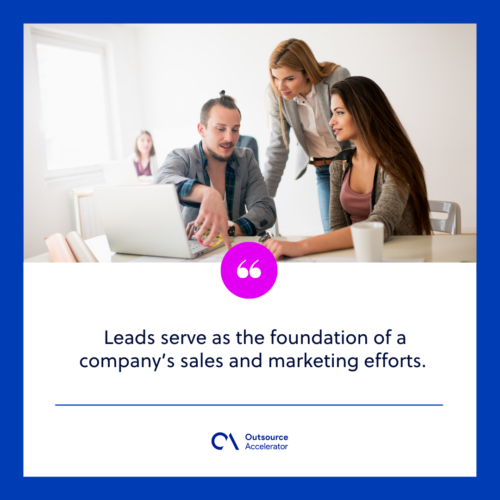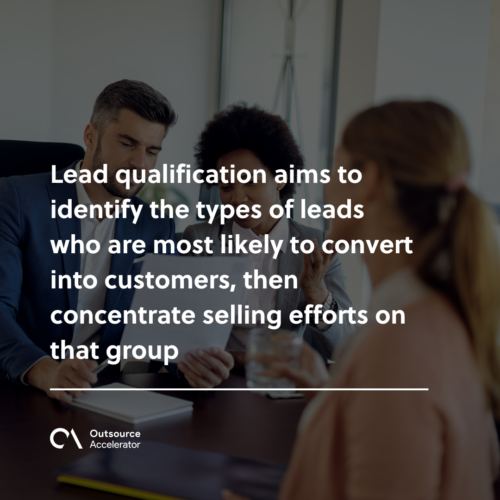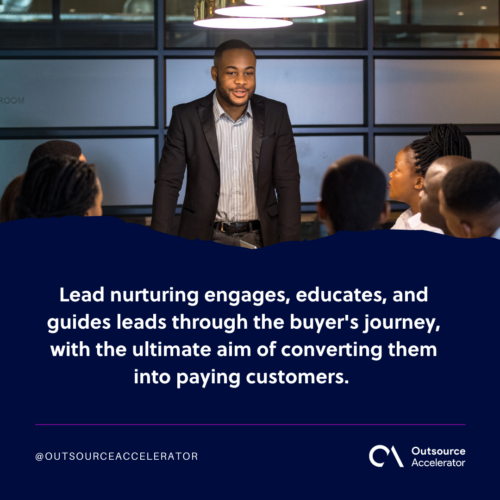9 must-know types of leads for successful sales and marketing

List of the types of leads
- Hot leads
- Warm leads
- Cold leads
- Information qualified leads/a>
- Marketing qualified leads
- Sales qualified leads
- Service qualified leads
- Product qualified leads
- Member service request leads
If you’re in the world of sales or marketing, you’ve probably heard the term “leads” tossed around more than a few times. It may surprise you, however, that there are different types of leads, each requiring a method of dealing with them.
Understanding the different classifications of leads can help you focus your sales and marketing efforts and ultimately bring in more business.
In this article, we’ll dive into the world of leads and explore the different types you need to know.
What are leads?
Leads in sales and marketing is a potential or prospective customer who has shown interest in a company’s products, services, or brand in some way.
Leads serve as the foundation of a company’s sales and marketing efforts. Different types of leads represent individuals or businesses that have demonstrated some level of interest in the company and may be open to further engagement.
The process of lead generation is crucial for businesses as it helps to expand their customer base and create opportunities for sales conversions.
Businesses actively capture and manage leads to nurture them through the buyer’s journey. The ultimate goal is to convert them into paying customers.
Leads play a vital role in driving business growth. They provide potential sales opportunities and allow companies to build relationships with their target audience.
This results in increased conversions and customer acquisition.

9 major types of leads in business
In the lead management process, leads are often categorized based on their level of engagement and readiness to make a purchase.
This categorization helps businesses prioritize their efforts, allocate resources effectively, and tailor communication to address the specific needs of different types of leads.
Here are nine major types of leads you should be aware of:
1. Hot leads
Hot leads are those who are actively interested and engaged in making a purchase. These types of leads are the easiest to convert into paying customers.
Hot leads often exhibit clear buying signals, such as requesting quotes, initiating direct communication, or expressing an urgent need for the product.
Businesses prioritize hot leads for immediate sales engagement because they are in the advanced stages of the buyer’s journey.
2. Warm leads
Warm leads are potential customers who have shown interest but are not yet ready to make an immediate purchase. Among the types of leads, warm leads have already engaged with a company but may still need more nurturing before buying.
Warm leads are in the consideration phase of the buyer’s journey. Thus, they require personalized communication and targeted content to build trust and move them closer to becoming sales-ready.
3. Cold leads
Cold leads have shown little or no prior interest in a company’s products. A cold lead has not interacted with any content, expressed any explicit interest, or taken actions leading to a purchase.
Cold leads are generally low quality and have a low conversion rate. These prospects require significant nurturing and marketing efforts from the sales team to capture their attention and move them through the sales funnel.
4. Information qualified leads
Information qualified leads are those that have shown significant interest in your company’s content and information. They may have engaged with your educational content or visited sites that contain information about your offerings.
Information qualified leads are identified based on their interaction with content marketing efforts. This places them at the very early stages of the buyer’s journey.
5. Marketing qualified leads
Marketing qualified leads are potential customers who have shown sufficient interest in the company’s offerings to be considered ready for marketing efforts.
Marketing qualified leads may have engaged with the company’s content, subscribed to newsletters, or attended webinars. These actions indicate their interest in learning more.
Marketing teams tend to focus on nurturing these types of leads by providing valuable content and targeted communication.
6. Sales qualified leads
Sales qualified leads are ones who have been evaluated and deemed ready for direct sales engagement. These types of leads have actively expressed interest and intent to purchase.
Sales qualified leads may have partaken in direct communication with the sales team, requested quotes, or shown specific buying signals.
These prospects are among the types of sales leads prioritized by sales teams for personalized and direct sales efforts. They respond to marketing materials, request demos, and even attend webinars.
A direct sales pitch is usually successful towards these prospects.
7. Service qualified leads
Service qualified leads have shown a strong interest in your company’s services and have engaged in interactions related to those services offered. Customer support teams identify and qualify these leads based on those interactions.
Service qualified leads are one of the types of leads that are frequently generated through advertising campaigns, referrals, and other marketing strategies. Many are also previous customers who are likely to use your services again.
8. Product qualified leads
Product qualified leads are potential customers who have demonstrated a high level of interest and engagement with a company’s product.
These people have already used the product by signing up for a free trial. They’re usually from your existing pool of clients, ready to buy more of what you offer.
Product qualified leads are considered high-quality due to their familiarity with your company and interest in your offering.
9. Member service request lead
Member service request leads refer to potential customers who are already members of a membership-based organization.
These people are current customers that have submitted inquiries or requests for assistance related to services provided by their membership.
These leads are crucial for maintaining customer satisfaction and retention within a membership-based organization. By promptly addressing their inquiries and providing support, you can enhance their overall experience.
Lead scoring and qualification
Lead scoring and qualification are essential to your marketing process. It helps you prioritize the types of leads you should focus on first and which can be safely ignored.
Lead scoring
Lead scoring assigns numerical values to each lead based on their level of interest and likelihood of buying. It helps sales representatives focus on the best prospects first to convert hot leads.
Lead scoring can also be used as a standalone tool.
Lead qualification
Lead qualification is where you determine whether or not to pursue a lead further. The goal is to identify types of leads who are most likely to convert into customers (usually hot leads), then concentrate selling efforts on that group.
There are many factors to be considered in lead qualification, including:
- How much they are willing to spend
- The amount of time they’re willing to commit
- Their role in the organization

Lead nurturing strategies
Lead nurturing strategies are a set of tactics and approaches used by businesses to build and maintain relationships with potential customers (leads) over time.
Lead nurturing engages, educates, and guides leads through the buyer’s journey, with the ultimate aim of converting them into paying customers.
Here are some common lead nurturing strategies:
Personalized communication
Successful companies don’t just send generic emails to their leads. And the best marketers know that personalization is key to succeeding at lead nurturing. Personalized communication builds trust and encourages prospects to buy sooner.
That’s why it’s important to build a profile of your ideal client. Ask yourself quotations such as:
What are they looking for?
What do they like?
What do they dislike?
It will be easier for you to create personalized messages that resonate with specific types of leads and help you stand out from the competition.
Content marketing
Content marketing is a great way to build relationships with all types of leads and nurture them through the sales cycle. This method is especially useful for B2B companies that want to sell more complex products and services.
Content marketing involves creating valuable and relevant content to build trust with your target audience and convert them into leads.
Content marketing is effective because people are likelier to buy from those they trust. When you provide worthwhile information through content, you demonstrate your expertise and help customers make decisions.
Segmentation
Segmentation is the process of dividing a large group into smaller ones. This allows you to identify and target customers based on demographic, behavioral, psychographic, and other characteristics.
Segmentation helps you address specific needs with relevant content and offers. It’s an important part of lead nurturing and increases the chances of converting different types of leads into customers.
Segmentation also helps marketers identify their most valuable customers and determine what they want from their relationships with brands.
Multi-channel engagement
Multi-channel engagement is the most effective way to nurture leads because it allows you to engage with them wherever they are. You can reach them through email, social media, or phone calls, just to name a few options.
A multi-channel approach ensures consistent messaging across all channels. People who contact you can feel like they’re talking to one person instead of several departments.
This will help you build relationships with them over time and give them a reason to continue interacting with your brand.
Retargeting and remarketing
Retargeting and remarketing are excellent ways to reach out to past visitors who may not have actually converted on their first visit.
Retargeting and remarketing, or “follow me” advertising, allows you to reach potential customers who have already made contact with your brand. The goal is to encourage them, even cold leads, to convert into customers.
This process works by serving ads that are specifically designed to remind people of the products they looked at or services they researched on your site. This can be a strong way to increase sales.
The key benefit of retargeting and remarketing is that it lets you aim for specific groups based on their behavior and past actions. It increases the likelihood that these people will purchase after seeing your new ad.

Importance of lead generation and management for business growth
Lead generation and management are crucial for business growth due to the following reasons:
- Expanding customer base – A robust lead generation strategy helps reach a wider audience and expands the customer base, leading to increased sales opportunities.
- Efficient resource allocation – Businesses can optimize their strategies for better efficiency and ROI by prioritizing the types of leads based on their interest and readiness to buy.
- Enhancing brand awareness – Lead generation efforts expose potential customers to a brand. Even if they don’t convert immediately, consistent exposure can help recognition.
- Data-driven insights – Analyzing valuable data and insights about customer behavior, preferences, and market trends helps businesses refine strategies and create opportunities for improvement.
- Competitive advantage – By consistently engaging with potential customers and nurturing different types of leads, companies can position themselves as industry leaders.
- Adaptability and growth – Lead generation and management strategies allow organizations to adapt to changing market conditions and customer needs.
- Positive customer experience – Proper management ensures that different types of leads receive relevant information to address their concerns. Providing a positive customer experience during this process enhances the company’s reputation and fosters customer loyalty.







 Independent
Independent




